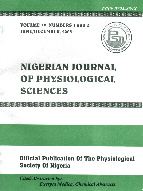
|
Nigerian Journal of Physiological Sciences
Physiological Society of Nigeria
ISSN: 0794-859X
Vol. 33, No. 2, 2018, pp. 169-175
|
 Bioline Code: np18026
Bioline Code: np18026
Full paper language: English
Document type: Research Article
Document available free of charge
|
|
|
Nigerian Journal of Physiological Sciences, Vol. 33, No. 2, 2018, pp. 169-175
| en |
Effects of Telfairia Occidentalis  Leaf Extract on Plasma Lactate and Liver Glycogen in Rats Leaf Extract on Plasma Lactate and Liver Glycogen in Rats
Salman, T.M.; Lawal, O.R.; S.O., Sulaiman; A.A., Feyitimi & A.R.A., Alada
Abstract
Summary: Telfairia occidentalis is a green vegetable popularly consumed among the native of Africa and it is generally believed to be of medicinal and nutritional value. Studies have reported its hypoglycaemic and hyperglycaemic effects in rats. In addition to these conflicting reports, the mechanisms for its effects on blood glucose remain inconclusive. The objective of this study was to investigate the mechanism involved in the increased blood glucose following treatment with T. occidentalis. Twenty five (25) male albino rats (200-250g) were randomly divided into 5 groups (n=5/group). Rats in the control group received normal saline while rats in other groups were orally treated with 100 or 200 mg/kg body weight of the extract for either 1 or 2 weeks. At the end of the treatment, the rats were anaesthetized and blood samples were collected for the estimation of some biochemical parameters. The results showed significant decreases in plasma glucose after 1 week of treatment with 100 mg/kg and 200 mg/kg. However, after 2 weeks of treatment with both doses, plasma glucose levels increased significantly and were higher than those of the control and the rats treated for 1 week with both doses. There were also dose- and duration-dependent decreases in glycogen concentration in the treated rats, especially those treated for two weeks. Glucose-6-phosphatase activity and liver glycogen concentration were lower in rats treated for 2 weeks when compared with those treated for 1 week with both doses. Moreover, plasma lactate concentration was lower in the treated groups when compared with control. The results suggest that Telfairia occidentalis-induced lowering of plasma glucose after one week of treatment probably favoured lactate oxidation/gluconeogenesis and elicited breakdown of liver glycogen which resulted in increased plasma glucose after two weeks of treatment.
Keywords
Blood glucose; Lactate; Liver glycogen; Glucose-6-phosphatase; Telfairia occidentalis
|
| |
© Copyright [2018] - Physiological Society of Nigeria
|
|
